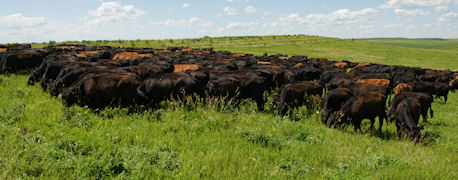Do you raise grass steers? A SARE-supported project conducted at the The Dickinson Research Extension Center in North Dakota found that properly managed forage supplies have the potential to increase rib-eye area in long yearling steers by 25 percent.
—————
Source: Cattle Network, by Chris Ringwall
Properly managed forage supplies have the potential to increase rib-eye area in long yearling steers by 25 percent. Occasionally, data comes across the desk that causes one to sit back and say: Wow, could you repeat that? Yes, properly managed forage supplies have the potential to increase rib-eye area in grass steers by 25 percent.
Long yearling steers, after a summer of grazing on perennial grass and then switching to annual crops in late August, averaged 10.9 square inches of rib-eye area. Meanwhile, those steers that only grazed perennial grass the whole season averaged 8.7 square inches of rib-eye area. The yearling steers that grazed annual crops late in the grazing season had 25 percent more rib-eye area at the end of the grazing season in mid-October.
Although the two groups were similar in total square inches of rib-eye area at harvest, those steers that grazed late-season annual crops spent 25 days less in the feedlot to reach similar end points. With a little pencil pushing, it did not take long to figure out which group returned more money. Those yearling steers that grazed on annual forage from mid to late August and well into October had improved performance.
Although there is a combination of nutritional effects going on, one notable deficiency in late- season pasture is protein. The value of protein is critical in grass cattle production. The Dickinson Research Extension Center (DREC), through research supported by the North Central Region Sustainable Agriculture Research and Education program, evaluated the impact of summer grazing systems followed by late-fall/early winter feedlot finishing.
The study was a two-year study that involved 144 large-framed steers that were divided into a feedlot only, pasture only or pasture with the addition of late- season annual crops as the three treatments.
This discussion will focus on the two pastured sets of cattle. In visiting with Songul Senturklu, visiting scholar from Canakkale Onsekiz Mart Universitesi, BMYO, Canakkale, Turkey, the steer calves were weaned in November and maintained on low-quality forage through the winter until spring, when the steers were assigned to one of the three treatments.
In the two treatments of interest, the steers were placed on crested wheat grass in early May and then switched to native range in early June. They were maintained on native grass until the third week in August. At that time, half the steers were moved to a field pea-barley pasture, followed by an unharvested corn field.
All the steers were shipped to the University of Wyoming’s Sustainable Agriculture Research Extension Center in Lingle to be fed to final harvest weight. Both groups of steers grazed for a little more than 180 days. However, half the steers only grazed on perennial pasture for approximately 104 days, followed by 27 days of grazing the field pea-barley pasture and finishing with
52 days of grazing unharvested corn prior to shipping to the feedlot. The difference between the forage crude protein was measured bimonthly in each pasture.
Senturklu indicated that the study design was to graze each forage type until the crude protein (CP) content declined to a range of 9 to 10 percent or the pasture or field was sufficiently grazed. Senturklu reported that the cool- season crested wheatgrass went from 18 percent CP in early May to 8.5 percent in early June.
The native grasses were at 13 percent CP in early June and decreased to a low of 7 percent in early August. The field pea and barley field went from 27 percent crude protein in mid-July to 15.8 percent in mid-August and then down to 13.5 percent in early September. The unharvested corn had 18 percent CP in mid-August and gradually decreased to 10 percent in mid-September and 7 percent by early October.
These late-season sources of nutrients had a beneficial effect on the yearling steers. The cool- season grass and native grass were an excellent summer protein source through mid-July. However, the late-season nutritional boost provided by grazing annual crops was very beneficial.
The center has been looking at various forages that may provide more protein than the traditional fall grasses by incorporating annual crops into the pasture rotations. Although only the beginning, Senturklu’s evaluations of seasonal change in crude protein for the crop mixture of field peas and barley, as well as corn, are a good start.
By grazing annual agronomic crops, livestock producers can find windows of increased available crude protein to feed to cattle that bring a very positive subsequent feedlot performance.
May you find all your ear tags.
Want more information? See the related SARE grant(s) Increasing Sustainability of Livestock Production of the Northern Great Plains , LNC11-335



